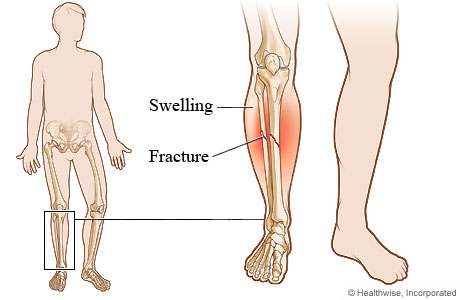Fracture
A fracture is a break in a bone.
Fractures can range from a hairline crack in the bone to the bone being broken into two or more pieces that no longer line up correctly. A fracture may occur at the same time as other injuries, such as sprains, strains, or dislocations.
Signs and symptoms of a fracture may include:
- A pop or snap felt or heard at the time of the injury.
- Pain that increases with movement or when pressure is applied to the area.
- Swelling and bruising in the injured area.
- Limited movement in the injured area.
- A bend or movement in a bone where there is no joint (for example, a bend in the arm between the elbow and wrist).
- Bone poking through the skin or visible in the wound.
A fracture and other injuries that often occur at the same time require medical attention. A health professional may set, cast, or splint a broken bone to help the bone heal. Some fractures may require surgery.
Recovery time for a fracture can vary from weeks to months depending on a person's age and health; the type, location and severity of the fracture; and whether there are other injuries that may make treatment more complicated.
Is it a Fracture?
Lower Leg Fracture

Stress Fractures
Stress fracture
A stress fracture is a hairline crack in a bone. In some cases, the crack may be so small that it is not visible on an X-ray.
Stress fractures are usually caused by repeated stress on a bone rather than by a specific injury. They can occur in any bone that repeatedly bears weight. For instance, stress fractures in the small bones of the foot are common during intensive training for sports that involve lots of running or jumping. A stress fracture is also more likely to occur in a bone that is not accustomed to or conditioned for a particular activity, such as when a person starts a new sport.
The most common symptom of a stress fracture is persistent pain at the site of the fracture. Pain may improve temporarily during exercise but gets increasingly worse after each exercise session.
If the activity that caused the stress fracture is stopped, the bone will heal and symptoms will go away. The activity can then be resumed gradually until the bone becomes conditioned to the repeated movements.
Copyrighted material adapted with permission from Healthwise, Incorporated. This information does not replace the advice of a doctor.

